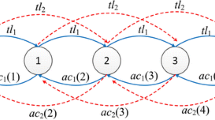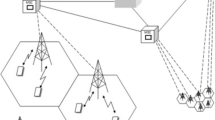Abstract
Spectral efficiency of WCDMA based spread spectrum 3G/4G air interface technology is highly influenced by the common channel interference, hence the applied Call Admission Control method has great importance because it determines the number of active users admitted to the network. In this paper we present a dynamic air interface CAC algorithm which provides efficient usage of radio resources and allows real-time adaptation to the always changing network parameters. Required CAC parameters are derived for generalized multiplicative fading and generalized memory-less traffic sources. In order to validate its capabilities our proposed CAC method was investigated with ON/OFF traffic sources and lognormal fading channels.
Similar content being viewed by others
References
J. Bíró, A. Gulyás and Z. Heszberger, A novel direct upper approximation for workload loss ratio in general buffered systems, {Lecture Notes in Computer Science}, 3042 (2005) 718–730.
J.A. Bucklew, Large Deviations Techniques in Decision, Simulation and Estimation (Wiley, New York, 1990).
J.P. Castro, The UMTS Network and Radio Access Technology: Air Interface for Future Mobile Systems (John Wiley {&} Sons, Chichester, England, 2001).
J.K. Cavers, Mobile Channel Characteristics (Kluver Academic Publishers, 2000).
Kelly (1991), A.I. Elwalid and D. Mitra, Effective bandwidth of general Markovian traffic sources and admission control of high speed networks, {IEEE/ACM Trans. Netw}, 6 (1993) 329–343.
J. Evans and D. Everitt, Effective bandwidth-based admission control for multi-service CDMA cellular networks, IEEE Transactions on Vehicular Technology, 1 (1999) 36–46.
J. Evans and D. Everitt, On the teletraffic capacity of CDMA cellular networks, IEEE Transactions on Vehicular Technology, 1 (1999) 153–165.
R.G. Gallager, Information Theory and Reliable Communication (John Wiley and Sons, 1968).
J.D. Gibson, (ed.)., The Mobile Communications Handbook (Springer Gmbh Germany, 1999), 2nd edition, ISBN 3-540-64836-4.
Y. Gou and H. Chaskar, Class-based quality of service over air interfaces in 4G mobile networks, {IEEE Communications Magazine}, 3 (2002) 132–137.
Z. Heszberger, J. Zátonyi and J Bíró, Performance bounds for rate envelope multiplexing, Performance Evaluation, 48 (2002) 87–101.
C.J. Ho, et al., On call admission control in} DS/CDMA cellular networks, {IEEE Transactions on Vechicular Technology, 38 (2001).
S. Imre and L. Pap, Neuron based call admission control method for transport network of 3rd generation mobile systems, IEEE Symposium on Communications and Vehicular Technology, (Leuven, The Netherlands, 2000).
S. Imre, et al., Efficient call admission control method for 3G/4G WCDMA networks, CONTEL2003, June 13–15 (Zagreb, Croatia, 2003).
F.P. Kelly, Effective bandwidth at multi-class queues, {Queuing Systems}, 11 (1991) 968–981.
I.M. Kim, B.C. Shin and D.J. Lee, SIR-based call admission control by intercell interference prediction for DS-CDMA systems, {IEEE Communications Letters}, 1 (2000) 29–31.
R. Nee and E. Prasad, OFDM for Wireless Multimedia Communications (Artech House Publishers, London, 2000).
OMNeT++, Simulation environment webpage (2005) http://whale.hit.bme.hu/omnetpp/
O. Sallent, J.P. Romero, R. Agusti and F. Casadeval, Provisioning multimedia wireless networks for better QoS: RRM strategies for 3G W-CDMA, {IEEE Communications Magazine} 2 (2003) 100–106.
D. Shen and C. Ji, Admission control of multimedia traffic for third generation CDMA network, in Proceedings of IEEE INFOCOM (2000) pp. 1077–1086.
D. Staehle, K. Leibnitz and K. Heck, A fast prediction of coverage area in UMTS networks, in Proceedings of IEEE Globecom, Taiwan (2002a).
D. Staehle, et al., Approximating the othercell interference distribution in inhomogeneous UMTS network IEEE VTC Spring (Birmingham, AL, 2002b).
D. Tse and S. Hanly, Linear multiuser receivers}: Effective interference, effective bandwidth and user capacity, {IEEE Transactions on Information Theory, 3 (1999) 641–657.
A.J. Viterbi, CDMA-Principles of Sperad Spectrum Communication (Addison-Wesley, 1995).
Author information
Authors and Affiliations
Corresponding author
Rights and permissions
About this article
Cite this article
Imre, S. Dynamic Call Admission Control for Centralized CDMA Systems. Telecommun Syst 29, 257–282 (2005). https://doi.org/10.1007/s11235-005-3269-8
Received:
Revised:
Accepted:
Issue Date:
DOI: https://doi.org/10.1007/s11235-005-3269-8




